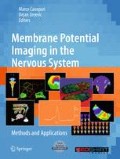Abstract
Studies in several important areas of neuroscience, including analysis of single neurons as well as neural networks, continue to be limited by currently available experimental tools. By combining molecular probes of cellular function, such as voltage-sensitive or calcium-sensitive dyes, with advanced microscopy techniques such as multiphoton microscopy, modern experimental neurophysiologists have been able to partially reduce this limitation. These approaches usually provide the needed spatial resolution along with convenient optical sectioning capabilities for isolating regions of interest. However, they often fall short in providing the necessary temporal resolution, primarily due to their restrained laser scanning mechanisms. In this regard, we review a method of laser scanning for multiphoton microscopy that overcomes the temporal limitations of pervious approaches and allows for what is known as Random-Access Multiphoton (RAMP) microscopy, an imaging technique that supports full three dimensional recording of many sites of interest on physiologically relevant time scales.
Access this chapter
Tax calculation will be finalised at checkout
Purchases are for personal use only
References
Bansal V, Patel S, Saggau P (2006) High-speed addressable confocal microscopy for functional imaging of cellular activity. J Biomed Opt 11:34003.
Bi K, Zeng S et al. (2006) Position of the prism in a dispersion-compensated acousto-optic deflector for multiphoton imaging. Appl Opt 45:8560–8565.
Bullen A, Saggau P (1998) Indicators and optical configuration for simultaneous high-resolution recording of membrane potential and intracellular calcium using laser scanning microscopy. Pflugers Arch 436:788–796.
Bullen A, Patel SS, Saggau P (1997) High-speed, random-access fluorescence microscopy: I. High-resolution optical recording with voltage-sensitive dyes and ion indicators. Biophys J 73:477–491.
Escobar I, Saavedra G et al. (2006) Reduction of the spherical aberration effect in high-numerical-aperture optical scanning instruments. J Opt Soc Am A Opt Image Sci Vis 23:3150–3155.
Fork RL, Martinez OE, Gordon JP (1984) Negative dispersion using pairs of prisms. Opt Lett 9:150–152.
Gobel W, Kampa BM, Helmchen F (2007) Imaging cellular network dynamics in three dimensions using fast 3D laser scanning. Nat Methods 4:73–79.
Iyer V, Losavio BE, Saggau P (2003) Compensation of spatial and temporal dispersion for acousto-optic multiphoton laser-scanning microscopy. J Biomed Opt 8:460–471.
Iyer V, Hoogland TM, Saggau P (2006) Fast functional imaging of single neurons using random-access multiphoton (RAMP) microscopy. J Neurophysiol 95:535–545.
Jenei A, Kirsch A, Subramaniam V, Arndt-Jovin D, Jovin T (1999) Picosecond multiphoton scanning near-field optical microscopy. Biophys J 76:1092–1100.
Koester HJ, Baur D, Uhl R et al. (1999) Ca2+ fluorescence imaging with pico- and femtosecond two-photon excitation: Signal and photodamage. Biophysi J 77:2226–2236.
Lechleiter JD, Lin DT, Sieneart I (2002) Multi-photon laser scanning microscopy using an acoustic optical deflector. Biophys J 83:2292–2299.
Lv XH, Zhan C et al. (2006) Construction of multiphoton laser scanning microscope based on dual-axis acousto-optic deflector. Rev Sci Instrums 77:046101.
Mogilevtsev D, Birks TA, Russell PS (1998) Group-velocity dispersion in photonic crystal fibers. Opt Lett 23:1662–1664.
Nakazawa M, Nakashima T, Kubota H (1988) Optical pulse-compression using a Teo2 acoustooptical light deflector. Opt Lett 13:120–122.
Pawley J (1995) Handbook of biological confocal microscopy, 2nd edn. Plenum, New York.
Reddy GD, Kelleher K et al. (2008) Three-dimensional random access multiphoton microscopy for functional imaging of neuronal activity. Nat Neurosci 11:713–720.
Reddy GD, Saggau P (2005) Fast three-dimensional laser scanning scheme using acousto-optic deflectors. J Biomed Opt 10:064038.
Saggau P, Bullen A, Patel SS (1998) Acousto-optic random-access laser scanning microscopy: fundamentals and applications to optical recording of neuronal activity. Cell Mol Biol 44:827–846.
Salome R, Kremer Y et al. (2006) Ultrafast random-access scanning in two-photon microscopy using acousto-optic deflectors. J Neurosci Methods 154:161–174.
Steinmeyer G (2006) Femtosecond dispersion compensation with multilayer coatings: toward the optical octave. Appl Opt 45:1484–1490.
Treacy EB (1969) Optical pulse compression with diffraction gratings. IEEE J Quantum Electron 5:454–458.
Vucinic D, Sejnowski TJ (2007) A compact multiphoton 3D imaging system for recording fast neuronal activity. PLoS ONE 2:e699.
Weber MJ (1986) Handbook of Laser Science and Technology. CRC Press, Boca Raton, FL.
Xu J, Weverka RT, Wagner KH (1996) Wide-angular-aperture acousto-optic devices. Proc SPIE 2754:104–114.
Zeng S, Lv X et al. (2006) Simultaneous compensation for spatial and temporal dispersion of acousto-optical deflectors for two-dimensional scanning with a single prism. Opt Lett 31:1091–1093.
Acknowledgements
The development of AOD-based fast 3D random-access multi-photon microscopy is the result of the continuing efforts of many members and affiliates of the Saggau lab. These efforts were supported by numerous grants from NIH and NSF, some of which were utilizing preliminary data obtained with equipment loaned by Coherent, Isomet Corp. and Nikon USA.
Author information
Authors and Affiliations
Editor information
Editors and Affiliations
Rights and permissions
Copyright information
© 2010 Springer Science+Business Media, LLC
About this chapter
Cite this chapter
Reddy, G.D., Saggau, P. (2010). Random-Access Multiphoton Microscopy for Fast Three-Dimensional Imaging. In: Canepari, M., Zecevic, D. (eds) Membrane Potential Imaging in the Nervous System. Springer, New York, NY. https://doi.org/10.1007/978-1-4419-6558-5_12
Download citation
DOI: https://doi.org/10.1007/978-1-4419-6558-5_12
Published:
Publisher Name: Springer, New York, NY
Print ISBN: 978-1-4419-6557-8
Online ISBN: 978-1-4419-6558-5
eBook Packages: Biomedical and Life SciencesBiomedical and Life Sciences (R0)

